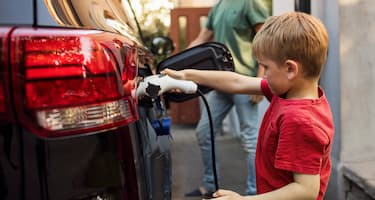From the coast to the country, there are sights to see all over Australia. But with so much land to cover, it’s no wonder Australians go through their fair share of fuel.
To better understand how Australians consume fuel, we surveyed more than 1,000 Australian drivers aged 18 and over.
We gathered data and analysed trends from Budget Direct’s Fuel Consumption Statistics and Survey 2022 to explore the role that a vehicle's fuel consumption plays in everyday life.
Quick Stats
- It costs Australians an average of $73.10 to refuel a car in 2023, which is almost $5 more than what it was reported to cost in 2022.
- Diesel cars, utes and 4x4s are the most expensive cars to fill up costing a reported average of over $100 per refuel.
- Since 2022, more respondents said they would opt for a more fuel-efficient car or electric vehicle if fuel prices continue to rise.
Fuel Consumption in Australia
From different cars to different driving habits, there are a number of reasons why some drivers use slightly more fuel than others.
While it might not seem like a big deal at the time, factors such as city driving or driving an SUV can make a huge difference to a car’s fuel consumption in the long run.
To help improve your car’s fuel consumption, you could:
- Reduce the weight of your car by removing heavy items or bulky roof racks etc.
- Stop or reduce the use of the air conditioner
- Avoid speeding and over-revving the engine
- Make sure your car is regularly maintained and serviced
Fuel Use
Australians have been using less fuel now than they were before the pandemic, with petrol sales in 2023 dropping below what they were in 2019.
Australia’s quarterly average petrol sales dropped to 2,206 million litres in the first three quarters of 2023.
This was around 3% lower than the quarterly average sales in 2022 and around 9% lower than the quarterly average sales in 2019. [1]
Quarterly Average Petrol Sales
The volume of petrol being sold to Australian drivers still hasn’t returned to what it was before the pandemic. This could be due to:
- Increasing hybrid and electric vehicles on Australian roads
- More people working from home rather than commuting to work
- Newer cars becoming more fuel-efficient
Fuel Emissions
A ‘green vehicle’ is considered to have a CO2 emission intensity of 120 g/km or less. [2]
In 2022, passenger cars and light SUVs had average tailpipe emissions of 131.1 g/km, which was a 10.5% decrease from the year prior.
Meanwhile, heavy SUVs and light commercial vehicles had an average of 212.8 g/km CO2 emissions in 2022.
From 2021 to 2022, medium passenger cars saw a 57% reduction in carbon dioxide emissions, which saw it become the car class with the lowest average emissions that year.
The major drop in emissions could possibly be linked to the rise in Tesla and Polestar vehicles, both of which predominantly sell fully electric medium passenger cars. [2]
Average CO2 Emissions in 2022
Fuel efficiency is on the rise in Australia with more people choosing to lower their carbon emissions by investing in the green vehicle market.
In Australia, battery electric, plug-in hybrid and hybrid vehicles made up 16.2% of all new vehicles purchased in 2023. [3]
In the past 12 months, the percentage of battery-electric vehicles sold in Australia almost doubled, increasing from 3.1% of all new vehicles bought in 2022 to 7.2% in 2023. [3] [4]
Fuel Cost
In Australia, petrol prices are made up of the international cost of refined petrol, taxes and other costs and margins. The price is measured in cents per litre (cpl) and can increase and decrease depending on several factors.
In the September quarter of 2023, the average cost of petrol in the five largest cities in Australia (Brisbane, Perth, Sydney, Melbourne and Adelaide) was 195.6 cpl. This was up 12.7 cpl from the previous quarter when the average cost of petrol was 182.9 cpl. [1]
Average Fuel Cost Breakdown 2023
Meanwhile, the cost of diesel was also up in Australia in the September 2023 quarter with the average coming in at 201.7 cpl in the five largest cities of the country.
This was an increase of 15.1 cpl when compared to the June quarter when the average was 186.6 cpl. [1]
Fuel Consumption Survey Results
To better understand how Australians feel about the state of fuel in Australia we surveyed 1,000 Australian drivers.
We then compared these results to our previous findings from our Fuel Consumption Survey and Statistics 2022 report to uncover ongoing trends in the industry.
What fuel does your primary, everyday car usually take?^
^Due to how the figures are rounded within the survey data, numbers may not add up to exactly 100%.
Unleaded petrol was the most common fuel choice for those surveyed with half saying they used Unleaded 95 and under, while one in five used Unleaded 98+.
Respondents from Queensland and New South Wales were the most likely to use Unleaded E10 in their vehicles. They were also some of the most likely states to use diesel, just behind respondents from Western Australia, where 16.4% said it was their go-to fuel type.
Meanwhile, more than two-thirds of those surveyed who drove 4x4 cars and utes said their vehicles ran on diesel, while a quarter of those who chose ‘other’ as their vehicle type said they used electricity, LPG or other fuel types.
In 2023, 2.6% of respondents said their cars ran on electricity, LPG or other forms of fuel. This result has risen since 2022 when just 0.4% gave the same response. [5]
How much would you usually pay to refuel your primary, everyday car?
Average Refill Cost |
|
|---|---|
Australia |
$73.06 |
NSW |
$75.63 |
Vic |
$72.14 |
Qld |
$69.71 |
SA |
$71.49 |
WA |
$73.61 |
According to our respondents, it costs an average of $73.10 to refuel a car in Australia.
The reported cost to fuel up has increased by almost $5 since 2022 when those surveyed said it cost them $68.94 on average to fill their car tanks. [5]
In Australia, car fuel prices rose by 7.9% in the 12 months to September 2023. They also increased by 7.2% in the September quarter, making it the largest quarterly increase since March 2022. [6]
For our respondents, fuel costs were the highest for diesel drivers, 4x4 owners and ute owners where the cost to refuel exceeded $100 on average.
Meanwhile, respondents who drove vehicles powered by electricity, LPG or other fuel types recorded the lowest average refuel cost at just $31.65.
Prices were the highest for those surveyed in New South Wales at $75.63 and the lowest for respondents in Queensland at $69.71.
Which timeframe best describes how often you would refuel your primary, everyday car?^
^Due to how the figures are rounded within the survey data, numbers may not add up to exactly 100%.
The majority of those surveyed said they refuelled their car once a fortnight. This was closely followed by 30.7% saying they refuelled once a week.
In South Australia, 14.9% of respondents said they refuelled their cars once or twice a week, which was more than all other states.
Meanwhile, those surveyed who owned a ute were the most likely to fill their cars more frequently with 7.5% saying they were fuelling up more than twice a week.
Almost a quarter of respondents who said they owned an electricity, LPG or any other fuel type car, said they fuelled their car up less than once a month.
Since 2022, respondents have been filling up their cars more regularly. The percentage of those saying they filled up once a week rose from 24.6% in 2022 to 30.7% in 2023.
Meanwhile, respondents who said they filled up once a month dropped from 19.8% in 2022 to 14.1% in 2023. [5]
How much fuel do you use now, compared to 12 months ago?^
^Due to how the figures are rounded within the survey data, numbers may not add up to exactly 100%.
Just under half of those surveyed said they are using the same amount of fuel now as they were 12 months ago, while almost one in three said they are using less or far less.
More than a quarter of those surveyed in Western Australia said they are using less fuel now than they were 12 months ago, while 21.1% of those in Victoria said they are now using more.
Those aged 38 to 47 who were surveyed were the most likely age group to spend more time on the road this year with 19.3% saying they used more fuel than a year ago and 6.1% saying they’d used far more.
Meanwhile, almost a quarter of those who drove vehicles with electric, LPG or other fuel types said they used far less fuel in the past 12 months.
If fuel prices were to rise by $1 per litre, would you consider replacing your car with something more fuel-efficient or electric?^
^Due to how the figures are rounded within the survey data, numbers may not add up to exactly 100%.
When compared to our previous survey, more respondents said they would opt for better fuel efficiency or an electric vehicle if fuel prices rose by $1 per litre.
The percentage of respondents who said they would consider the change increased from 43.8% in 2022 to 49.3% in 2023. [5]
Victoria was the only state where the majority of those surveyed said they would choose a more fuel-efficient car if prices continued to rise, according to 52.2% of respondents.
Meanwhile, 59.5% of those surveyed aged 38 to 27 said they would choose a more fuel-efficient car, while around two-thirds of respondents aged 58 to 75 said they wouldn’t consider changing cars if fuel prices rose.
Despite having the most expensive average refuel cost, diesel car owners were the least likely respondents to say they would consider making the change to something more fuel-efficient.
Key Takeaways
Motorists Face Rising Fuel Prices
The average cost to refuel a car has increased since 2022. Respondents said filling their cars in 2023 cost them almost $5 more on average than it did the year prior.
On average, those surveyed said they spent $73.10 on fuel for their car, which was up from $68.94 in 2022.
Respondents with the most expensive fuel costs included those who owned 4x4s at $111.99 per refuel, followed by diesel car owners at $103.04 a tank and ute owners at $102.65.
Overall, the cost of vehicle fuel in Australia rose by 7.9% in the year to September 2023. [6]
Green Vehicles on the Rise
Since 2022, an increasing number of respondents said they would opt for a more fuel-efficient car or an electric vehicle if fuel prices rose by $1 per litre.
Meanwhile, 2.6% of respondents said their cars ran on electricity, LPG or other forms of fuel in 2023. This percentage has increased since 2022 when just 0.4% gave the same response.
In Australia, green vehicles are on the rise with 16.2% of all new vehicles purchased in 2023 being either battery-electric or hybrid. [3]
Less Fuel Used on Australian Roads
Almost one in three respondents said they were either using less or far less fuel now than they were 12 months ago.
In 2023, there was 9% less petrol sold in Australia when compared to pre-COVID levels.
The reduced volume of petrol purchased by drivers can potentially be linked to the rise in fuel-efficient, electric and hybrid vehicles on the road as well as more people working from home rather than driving into the office. [1]






